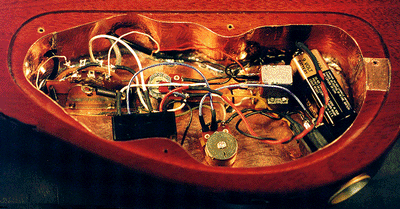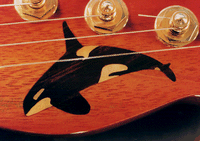
TELE® STYLE GUITARS
continued from page two
Copper Foil Faraday Shield One of the most important features of any good electric guitar is the ability to block out electro-magnetic "hum" often associated with single coil pickups. .0005" thick copper foil (available from WD Music Products) is used to line the control cavity in an effort to create an effective Faraday Shield which is used to block electro-magnetic interference which often results in an irritating hum. The more complex the circuitry, the more wire that exists, the greater the possibility that the wiring will, in effect, become an antenna that captures ambient electro-magnetic "noise" from the surrounding atmosphere (florescent lights, light controllers, transformers, amplifiers, etc.). Additionally, single coil pickups are, by their very nature, prone to producing some degree of hum (after all a pickup is a large coil of wire, and thus an antenna itself). Often times the pickups themselves are shielded, but tone degradation can occur if this is done improperly. Minimization of electro-magnetic hum is possible if the shielding is done with care and properly bonded to "ground." The shield, in effect, creates a force field around the various components and wires in the control cavity and helps keeps hum to a minimum by blocking out electro-magnetic interference. The result is a clean nearly hum free signal. This resulting improved signal to noise ratio translates to a cleaner output from the amplifier, and thus, the musician (his "noise gate") and his audience are subjected to much less noise and "hum." | |
| |
Orca -- First page
Photograph index | Reading List | FAQs | Home Page | E-mail
copyright 1997 anthony huvard, http://www.cybozone.com site maintained by cyboboy@cybozone.com

